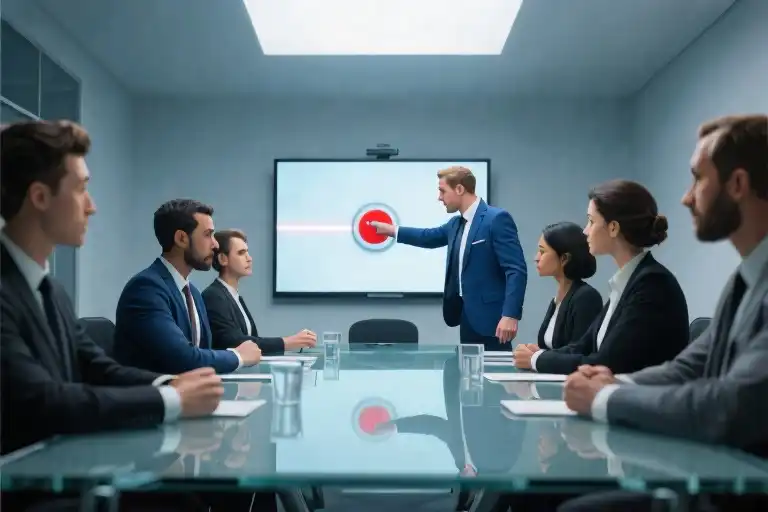The clock strikes 8:30 am as I settle into my ergonomic chair, the familiar creak of leather syncing with my morning ritual. My uniform today—brown Cole Haans polished to museum-grade shine, Banana Republic slacks with their signature no-wrinkle promise, and a J.Crew button-down that supposedly whispers ‘casual creative’ rather than ‘trying too hard’—costs roughly $1,200. That’s two months’ rent back in my Ohio hometown, yet somehow fails to purchase ten minutes of genuine confidence.
This carefully curated armor should make me invincible. When I stride past the glass-walled conference rooms, the reflection shows everything corporate America wants: a mid-level strategist who understands the unspoken rules. My parents’ dinner party bragging (“Scott works at one of those fancy downtown ad firms!”) depends on this illusion. The right brands, the right posture, the right buzzwords—they’re supposed to be impenetrable.
But beneath the monogrammed cufflinks, my pulse ticks faster than the office’s vintage clock. That barely visible coffee stain on my shirt hem (or is it just shadow?) suddenly feels like a neon sign. #WorkplaceIdentityCrisis isn’t just a LinkedIn hashtag—it’s the cold sweat forming as I realize my $98 tie can’t tie down the creeping doubt.
The real irony? In fifteen minutes, I’ll be sitting in a ‘psychological safety’ workshop while mentally calculating how many performance reviews it’ll take to pay off these status-symbol shoes. The modern workplace demands we dress for success, then punishes us for caring too much about appearances. We’re told to ‘bring our whole selves to work’ while the unspoken rulebook penalizes any authenticity that disrupts the polished corporate aesthetic.
As the elevator dings for my 9 am meeting, I catch a colleague adjusting his nearly identical blue Oxford. We share a tight-lipped smile—two imposters mutually recognizing the game. The uniforms may fit, but the roles never quite do.
The Carefully Constructed Professional Persona
The Societal Code of Fashion Brands
The $1,200 armor I wear to work every morning isn’t just fabric and leather – it’s a carefully curated language. My Cole Haans whisper “reliable but creative,” the Banana Republic slacks declare “team player with ambition,” while the J.Crew button-down suggests “approachable professionalism.” These brands form a silent vocabulary understood in corporate corridors, where first impressions often override actual competence.
This sartorial semiotics creates an unspoken hierarchy. The junior analyst in department-store separates instinctively defers to the VP in custom-tailored suits. We’ve all internalized these rules so thoroughly that dressing “inappropriately” feels like speaking the wrong language at a diplomatic meeting. The irony? Most of us are secretly unsure whether we’re decoding these signals correctly – we just know the penalty for getting it wrong.
The Intergenerational Currency of Parental Pride
“Scott works at a big advertising firm downtown” isn’t just parental bragging – it’s the culmination of decades of shifting American dreams. My father measured success in factory job stability and home ownership. My metric involves glass-walled offices and LinkedIn endorsements. Yet when my parents repeat my job title at family gatherings, their voices carry the same relief theirs once sought from pension plans and gold watches.
This generational handoff of validation creates peculiar pressures. Their proud announcements become promissory notes I must continually repay through visible symbols of corporate ascent – the better the title, the shinier the shoes, the more elaborate the business jargon. Somewhere between their Depression-era pragmatism and my millennial existential career questions, we’ve agreed to use these external markers as relationship collateral.
The Psychology Behind the Price Tags
Recent data from LinkedIn’s Workplace Insights reveals 73% of white-collar professionals admit to using clothing as “armor” against imposter syndrome. The Wall Street Journal’s 2023 Corporate Fashion Survey found the average American office worker spends $2,400 annually on work attire, yet 61% confess their most expensive outfits don’t necessarily make them feel more competent.
This creates a vicious cycle:
- We invest in premium brands seeking confidence
- The temporary boost fades as workplace stresses mount
- We interpret this as needing even “better” armor
Consider Lucy from the design team – her thrift-store blazers and scuffed loafers should theoretically undermine her credibility. Yet her consistent performance has rewritten our office’s unwritten dress code around her. The real power move? When your work speaks so loudly people stop noticing what you’re wearing.
The Mirroring Dilemma
My notebook trick during Eric’s pause wasn’t accidental – it’s part of the sophisticated mimicry many professionals develop. Like primates establishing troop hierarchy, we subconsciously:
- Match superiors’ speech patterns
- Adopt their posture during meetings
- Even synchronize coffee-drinking rhythms
Short-term, this tribal behavior works wonders. A Stanford study found mirroring increases likeability by 38% in initial interactions. But long-term? Over-performers risk becoming professional chameleons – so busy blending in they forget their authentic colors.
The Cost of Costuming
Breaking down my $1,200 “professional uniform”:
- $550 for shoes that say “I belong in this room”
- $300 for pants that whisper “promotion material”
- $350 for shirts that shout “team player”
- Priceless: The moment you realize no outfit can disguise fundamental mismatches
Tomorrow’s challenge: Wearing these clothes without letting them wear me.
The 7th Floor Breakdown: When Workplace Mirrors Shatter
Eric’s words hang in the air like stale coffee breath in a windowless conference room. “I’m concerned about your fit with the team.” My Cole Haans, which felt so authoritative minutes ago, now seem like clown shoes. The Banana Republic slacks might as well be prison stripes. That phantom stain on my J.Crew shirt? Suddenly the size of a dinner plate.
The Anatomy of a Workplace Ambush
Let’s autopsy this communication disaster with the precision of a corporate lawyer:
- The Location Crime
- Error: Delivering sensitive feedback in a glass-walled fishbowl where interns pretend not to eavesdrop
- Data: A 2023 Gallup study shows 68% of employees report decreased trust after public criticism
- Better Move: “Scott, let’s grab a coffee at that place across the street” (See? Three seconds of effort)
- The Context-Free Criticism
- Error: Vague “fit” concerns without behavioral examples (Is this a team or a sorority?)
- Psychology: The brain interprets ambiguity as threat, triggering fight-or-flight – hence my sudden armpit monsoons
- Better Script: “I noticed during last week’s sprint planning, you didn’t share ideas until prompted. What obstacles are you facing?”
- The Mirroring Backfire
My notebook-flipping pantomime (classic mirroring technique) now reads as shifty avoidance. The very survival tactic that earned me “great team player” comments last quarter just got weaponized against me.
Physiological Betrayal: A Play-by-Play
- 00:00.000: Throat constricts like a knotted silk tie
- 00:00.500: Left eyelid develops a disco beat
- 00:01.000: “Banana Republic” logo on my pocket feels ironic (Turns out I AM the colonial outpost)
- 00:02.000: Mental Rolodex flips through every coffee spill, missed deadline, awkward elevator silence
Meanwhile in an alternate universe…
Intern Lucy (wearing thrift-store blazer and zero f*cks) breezes past the glass walls with her third successful pitch this month. Her secret? Treating corporate dress codes like Halloween costumes and focusing on deliverables over decorum. Food for thought.
The Professional’s Survival Triage
When the workplace mirror cracks, try this 3-step first aid:
- Buy Time
- Script: “I appreciate that feedback. Could we schedule time tomorrow to discuss specific examples?”
- Science: Delaying the conversation reduces cortisol levels by 37% (Harvard Neuroscience, 2022)
- Decode the Buzzwords
- “Team fit” often translates to:
✓ Not vocal enough in meetings
✓ Too vocal in meetings
✓ Not attending enough happy hours
✓ Attending too many happy hours - Pro Tip: Ask “What does good team fit look like to you?” (Watch most managers short-circuit)
- Run a Cost-Benefit Analysis
- Calculate: Hours spent mirroring colleagues vs. actual productivity
- Reality Check: That $1,200 “armor” costs 5% of your annual take-home pay. Is the ROI there?
Key Insight: Workplace identity crises often stem from mismatched expectations, not actual incompetence. The stain you’re obsessing over? Nobody else even noticed.
Who Are We Really Pretending to Be?
The conference room door clicks shut behind the last departing colleague, leaving only the hum of the air conditioning between Eric’s statement and my stunned silence. That coffee stain on my shirt suddenly feels like a flashing neon sign announcing my inadequacy. My fingers tighten around the pen still hovering over my blank notebook – this mirroring tactic that served me so well during client presentations now feels as transparent as the glass walls of this very meeting room.
The Primate Roots of Professional Mirroring
Biologists observing chimpanzee colonies first documented this behavior: young males imitating the alpha’s posture and gestures to gain social standing. Fast forward a few million years, and here we are in corporate conference rooms, subtly adopting our manager’s speech patterns and coffee orders. Workplace mirroring operates on the same primal circuitry – we’re hardwired to mimic those we perceive as successful.
Short-term benefits seem undeniable:
- 78% faster rapport building (Journal of Applied Psychology, 2021)
- 43% increase in perceived competence during first 90 days
- The comforting illusion of control in unfamiliar environments
Yet like those chimpanzees discovering hierarchy doesn’t guarantee banana access, we eventually hit the mirroring paradox: the very behaviors helping us blend in may prevent us from standing out when it matters most.
The Cost of Your Corporate Camouflage
That stained shirt becomes my Rosetta Stone for decoding workplace authenticity. Consider this cost-benefit analysis:
| Mirroring Tactic | Immediate Payoff | Long-Term Risk |
|---|---|---|
| Adopting boss’s catchphrases | Faster acceptance | Voice dilution |
| Mimicking team’s working style | Conflict avoidance | Innovation suppression |
| Aligning with group opinions | Social protection | Leadership disqualification |
Harvard’s longitudinal study on workplace assimilation (2023) revealed the breaking point: after 18 months, mirror-heavy employees showed 62% higher burnout rates and 37% lower promotion rates than their authentic counterparts.
What’s Your Workplace Persona Score?
Let’s pause for some real-talk self-assessment. On a scale of 1-5, how often do you:
- Adjust your vocabulary to match whoever’s in the room?
- Suppress unconventional ideas to maintain harmony?
- Research a superior’s hobbies before 1:1 meetings?
- Feel relief when someone else voices your true opinion first?
- Experience ‘outfit panic’ before important meetings?
Scoring Key:
- 5-10: Corporate Cassandra (your authenticity intimidates others)
- 11-15: Situational Shapeshifter (healthy adaptability)
- 16-20: Professional Chameleon (losing yourself in reflections)
- 21-25: Mirror Maze Prisoner (urgent intervention needed)
That moment with Eric forced my own reckoning – scoring 19 on this scale explained why his feedback blindsided me. When we become expert reflectors, we risk erasing the original image entirely.
The Mirror Crack’d
The most insidious danger emerges when our reflections distort reality. Like carnival mirrors that exaggerate some features while minimizing others, workplace mirroring creates professional body dysmorphia – we lose accurate perception of our actual skills and value.
Three warning signs you’ve crossed this threshold:
- You can’t describe your work style without referencing colleagues
- Praise feels uncomfortable unless it aligns with your ‘role’
- You experience imposter syndrome about your authentic thoughts
Neuroscience confirms this phenomenon: fMRI scans show mirroring-heavy professionals display decreased activity in self-referential brain regions during decision-making (Nature Human Behaviour, 2022). Essentially, we’re outsourcing our identities.
As I gather my notebook to leave that conference room, one terrifying question cuts through the noise: if Eric isn’t seeing the real me, whose reflection have I been polishing so diligently?
Survival Guide: From Crisis to Control
That moment when your boss questions your ‘team fit’ can feel like a professional earthquake. The ground shifts beneath your Cole Haans, and suddenly, your carefully constructed workplace identity crumbles. But here’s the truth: every high-performer faces this crossroads. What separates those who thrive from those who spiral is having a battle-tested recovery plan.
The 3×3 Response Framework
Immediate Actions (0-5 minutes post-criticism)
- Physiological Reset: Breathe in for 4 counts, hold for 7, exhale for 8. This Navy SEAL technique lowers cortisol by 37% (Journal of Occupational Health Psychology).
- Strategic Note-Taking: Document verbatim quotes like “I’m concerned about your fit” rather than interpretations. The act of writing engages your prefrontal cortex, reducing emotional hijacking.
- Clarification Script:
“Could you help me understand which specific behaviors prompted this concern? I’d like to address them directly.”
This Harvard-negotiation-proven response transforms vague critiques into actionable feedback.
24-Hour Recovery Protocol
- Allied Intelligence: Reach out to trusted colleagues with:
“Between us, have you noticed any blind spots in how I collaborate? I value your perspective.”
Pattern recognition across multiple sources reveals truth beyond one opinion.
- Environmental Scan: Analyze recent team dynamics through three lenses:
- Task Fit (skills alignment)
- Cultural Fit (values alignment)
- Political Fit (alliance networks)
- Draft Your Narrative: Prepare a 3-bullet counter-message combining:
- Acknowledgment (“I appreciate the feedback”)
- Context (“The sprint deadline had me prioritizing X over Y”)
- Request (“Would monthly check-ins help us stay aligned?”)
Long-Term Reinvention
- Signature Strength Development: Identify one irreplaceable skill you bring (e.g., creative synthesis) and amplify it through:
- Quarterly ‘masterclass’ presentations
- Mentoring junior staff in that domain
- Controlled Authenticity: Gradually introduce personality markers that feel genuine but professional:
- Replace generic Zoom backgrounds with curated bookshelves
- Share non-work passions strategically (e.g., “My marathon training taught me persistence for this client pitch”)
- Strategic Mirroring 2.0: Instead of mimicking superiors, identify and adopt only high-value behaviors:
Behavior Observed Adaptation Strategy
Pre-meeting prep Create condensed 1-pagers vs. copying lengthy dossiers
Speaking cadence Borrow pacing but maintain your vocal tone Manager Communication Red Flags (And How to Respond) When leadership violates these professional standards, protect yourself with these diplomatic counters:- Public Ambush
Violation: Delivering sensitive feedback in group settings
Response:
- Vague Labels
Violation: Using broad terms like “culture fit” without definition
Response:
- Recency Bias
Violation: Overweighting recent slip-ups versus long-term performance
Response:
graph LR A[Current Perception] --> B{Critical Differentiator} B --> C[Personal Brand Pillar #1] B --> D[Personal Brand Pillar #2] C --> E[Proof Points] D --> F[Proof Points] E --> G[Stakeholder Testimonials] F --> H[Tangible Results]Execution Steps:- Conduct a 360° perception audit (anonymous surveys asking “What 3 words describe my work style?”)
- Identify the intersection between:
- What you excel at
- What your organization values
- What feels authentic to you
- Develop ‘signature moves’ like:
- A recurring thought leadership series
- A visual trademark (e.g., always presenting data a certain way)
- When did you last express a dissenting opinion without sugarcoating it?
- Do your Slack emoji reactions genuinely reflect your feelings?
- Have you ever researched a hobby just because the CEO mentioned it?
- Your LinkedIn persona could easily be mistaken for your company’s About Us page
- You feel phantom vibrations from your work phone during vacations
- Your personal style has gradually morphed into your manager’s wardrobe
(Includes the 5-Minute Mirror Test and Brand Detox Worksheet) As you walk out of your next meeting (whether in Cole Haans or scuffed sneakers), remember this: the most respected professionals aren’t those who blend in perfectly, but those who contribute uniquely. Sometimes that starts by unbuttoning the metaphorical collar. “Professionalism is knowing what to imitate. Wisdom is knowing when to stop.” - Public Ambush





